Top Story: Transportation
Working toward a safer Blue Line
August 29, 2013
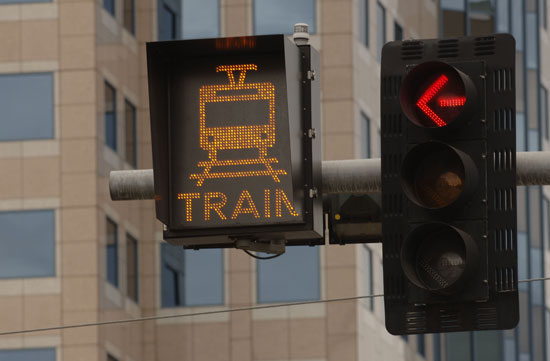
LED signs like this one in Long Beach alert pedestrians to stay off the tracks when a train is coming. Photos/Metro
One year after a task force convened to improve safety on Los Angeles Metro’s Blue Line, newly-released figures show that, while progress is being made, the line remains the deadliest in the system.
Abdul Zohbi, a system safety manager who organized the task force, says every fatality is reason for concern, but that he’s not ready to panic.
“All of our safety projects are being worked on as we speak,” Zohbi said.
Last July, officials discovered a spike in fatalities on the 22-mile light rail line from Downtown Los Angeles to Long Beach. It was on pace to experience the highest number of accidental fatalities and suicides of any year since it opened in 1990.
Acting on a motion by Supervisor Zev Yaroslavsky, Metro’s Board of Directors approved the creation of a Blue Line Task Force to find solutions for the agency’s oldest rail line.
“With our new lines, we are installing state-of-the-art devices that have come into existence in the past 20 years,” said Vijay Khawani, Metro’s executive officer of corporate safety. “A year ago we said, ‘Wait a minute, why can’t we retrofit the Blue Line?’”
Zohbi reached out to the City of Los Angeles’ Department of Transportation, the California Public Utilities Commission and Union Pacific Railroad, which runs a freight line directly alongside the Blue Line. He also invited representatives from Didi Hirsch Mental Health Services, a Culver City nonprofit organization that operates a 24-hour suicide crisis hotline.
The resulting recommendations were approved by the Board last December, and included $7.7 million for such physical improvements as pedestrian gates, bright LED signs and audible warning bell devices, although it has taken time for the measures to work their way through the bureacracy. Additional training is underway for light rail vehicle operators, including 2 days walking the line to experience the environment as pedestrians. And educational outreach to communities, another major part of the new safety program, has begun as well. “We expect the public to do their part in heeding the signs,” Zohbi said.
The outreach and training have already begun, and most of the physical improvements like the new LED signage are expected to be finished by around June of next year. But the improvements Zohbi believes will be most effective—108 new pedestrian gates—must be contracted out competitively, which will take longer.
In the meantime, safety issues continue to plague the Blue Line. According to statistics released Monday, it experienced more accidents and fatalities than all other Metro lines combined since the beginning of 2012, accounting for 56 of 77 accidents involving trains and pedestrians or cars during the period, along with 12 of 14 total fatalities.
“We need a physical barrier to stop people trying to cross the tracks illegally,” Zohbi said. “The No. 1 cause of accidental fatalities on the Blue Line is pedestrians running to catch a train. When you’re trying to save 30 seconds, you could lose your life.”
Tragically, even more deaths are intentional—half of the fatalities in 2012 and 75 percent of deaths so far this year were suicides. The task force called for suicide prevention signs with Didi Hirsch’s 24-hour hotline number to be installed at stations and other key locations. Those signs are 90 percent installed along the Blue Line. When that job is finished, they’ll be installed on the rest of the rail system.
Lyn Morris, who represented Didi Hirsch on the task force, said the signs represent “a big step ahead” by Metro.
“It wasn’t always popular to put the word ‘suicide’ on signs,” Morris said. “People like to talk around it, but when you are talking to someone who is suicidal you need to address it directly.”
The signs have only been in place for a couple of months, but Morris said her agency has already fielded calls generated by them, including some from people in a state of crisis. But beside that point-of-contact intervention, she said the signs serve a much broader purpose—spreading the word to communities across the county that someone is out there to listen and help at the most seemingly-hopeless times.
Both Morris and Bruce Shelburne, Metro’s rail operations chief, admitted that it’s next to impossible to eliminate all accidents resulting from people who break the law or attempt suicide.
“We are eating an elephant one bite at a time,” Shelburne said. “It’s a fine line—the safest train is one that doesn’t run at all.”
The Blue Line faces unique challenges. For one, it is Metro’s oldest rail line; the Teenage Mutant Ninja Turtles were used to promote its June, 1990, opening. And it runs through a densely populated part of town, with 103 at-grade crossings with other streets. Over the first 12 years of the line’s operation, it experienced more fatalities than any other line in the nation. In 1999, after a particularly rough year, Metro added safety measures that cut deaths by nearly half during the next decade.
While behavior of pedestrians and vehicular traffic can’t be predicted to a certainty, Zohbi called all fatalities “unnecessary.”
“To bring the fatalities down to zero,” he said, “that is our optimal goal.”
Posted 8/29/13
Expo shutterbug says so long
August 14, 2013
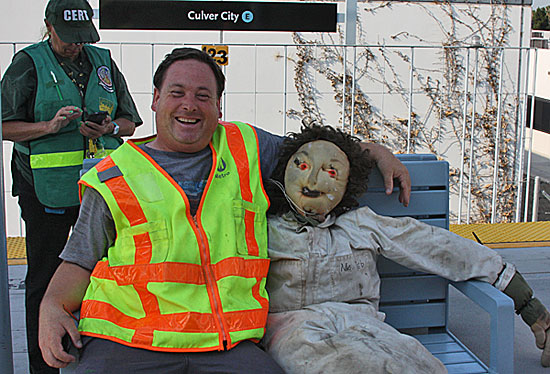
Dwight Sturtevant, aka Expo Line Fan, on the other side of the camera with Metro's crash dummy, Ms. Deb.
By profession, he’s a television engineer. But when he dons a fluorescent yellow vest and picks up his Canon EOS 40D camera, Dwight Sturtevant transforms into…Expo Line Fan.
At least he did until this week.
After nearly three years of chronicling the second, final phase of the Expo Line light rail project down to the last rivet and rebar, Sturtevant is leaving town for a new job in Ohio—and leaving behind a project he has documented in thousands of images and nearly three dozen videos since 2010.
Through it all, Sturtevant has worked anonymously and without compensation, with public credit for his photos going simply to “Expo Line Fan,” if it was given at all. But now, at last, his story can be told.
“I am just a rail fan who has been unofficially the project photographer,” the prolific volunteer said recently as he took a break from packing for the move. “I’ve had a free hand.”
Using his own photo equipment and wearing a Metro safety vest and a hard hat he purchased himself, Sturtevant has become a familiar figure on construction sites all along the 6.6-mile stretch where work is now underway to extend Expo from Culver City to Santa Monica.
His photos have appeared on Metro’s blog The Source, on the project’s website, on Supervisor Yaroslavsky’s website, in construction trade journals and on his own voluminous photo-sharing site.
“We use his pictures even in our office. It’s just built so much enthusiasm,” said Skanska USA Civil Executive Vice President Mike Aparicio, who added that Sturtevant’s outlook on the project has rubbed off on the whole Expo team. “When they see that kind of enthusiasm, they just feed on it.”
“He’s done a great job of capturing key milestones and highlighting progress,” Gabriela Collins, Expo’s government/community relations manager, said in a statement. “We thank him for sharing his wonderful photos and wish him well!”
While others have chronicled Expo’s progress in photographs, “Dwight has taken more than anybody,” and got unique shots because of his access to the construction process, said Darrell Clarke, a founder and co-chair of Friends 4 Expo Transit, longtime advocates for the project. “I’ve enjoyed his passion for following the project,” Clarke said.
Since his photo odyssey began, he has regularly delivered his copious output to the contractor, Skanska USA, to the Expo Construction Authority and to the Metro Library’s archives. It adds up: “If you figure every week since 2010, 200 pictures every week—do the math. It comes out to a lot of pictures.”
His connection to the project began—as so many L.A. adventures do—with a search for an alternate route. He was commuting at the time between downtown Los Angeles and the airport area and started to use Flower Street and Exposition Boulevard to get home. “And that’s when I went, ‘Wow, they’re building a light rail project.’ ”
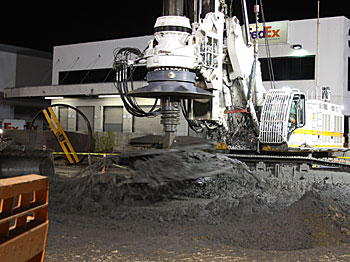
One of his favorites: time lapse shot of drilling for the Venice Boulevard Bridge. Photo/Dwight Sturtevant for Expo and Metro
When the company he was working for relocated to New Mexico, Sturtevant had more time on his hands and he was able to devote two days a week to photographing Expo.
“Over the last 2½ years, I’ve gotten the respect of Skanska where they’ve allowed me access to the project. Metro’s given me access to do certain things because I’ve earned the trust slowly, proved I wasn’t some nutcase,” he said.
He’s also become a familiar face to Metro’s train operators. For the past two years, he’s been printing up large posters with collages of his photographs to show them the project’s progress. He dropped off his last one at the 7th Street Metro Center last week, with a note: “To all my friends at Metro, I will miss you…I hope you have enjoyed the photos. Dwight S., aka the Expo Line Fan.”
Sturtevant, 51, said he has boyhood memories of looking at freight trains with his grandfather. His rail enthusiasm, literally, came with the territory: “I grew up in Boston. We had the first subway system in the country.”
His wife isn’t so keen on his hobby, however. He said her attitude is best summed up as: “If you’ve seen one train you’ve seen ‘em all.”
But he views his Expo work as a chance to make a difference, and to be an eyewitness to the construction of a light rail project that, in part, moves along the same route once traveled by the city’s late, lamented Red Cars.
“There’s not many places in the country where you’re able to watch cities regain what they’ve lost,” he said. “I mean, L.A. had all this once, and then we lost it.”
Sturtevant said he will be back for the project’s grand opening in 2015, and sooner if he can. In any case, the move to Ohio—where he’ll work for a mobile TV company that records professional sporting events—has at least one advantage for a train buff.
“The house has a big basement,” he said. “I’m going to be able to put my model railroad back up.”
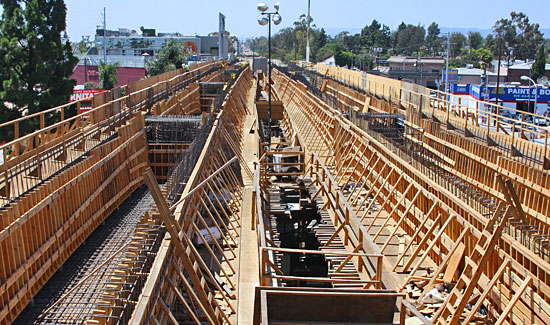
The Venice Boulevard Bridge, under construction last week. Photo/Dwight Sturtevant for Expo and Metro
Posted 8/13/13
End of the line for Expo legal challenge
August 7, 2013
A long-running legal challenge to the Exposition Line light rail project, now under construction from Culver City to Santa Monica, was stopped in its tracks this week by the California Supreme Court.
In a 6-1 decision, the court ruled against the group called Neighbors for Smart Rail, which contended in its lawsuit that the environmental reviews for the second and final phase of the Expo project had been inadequate.
The high court said the environmental information considered was sufficient, although they did agree with the plaintiffs on one point: they found that the project should have considered 2015 conditions—not 2030 conditions—in assessing potential impacts. But even so, the justices found, the process “did not deprive the agency or the public of substantial relevant information on those impacts.”
Expo backers hailed the ruling as the last chapter in a lengthy legal battle and said it clears the way for completion of the project, which will provide a transit alternative on a route that for the most part parallels the heavily-congested 10 Freeway.
“With this litigation now behind us, Westside residents can look forward to an exciting new public transit option when the Expo Line is scheduled to open in 2015,” Supervisor Zev Yaroslavsky, a member of the Exposition Light Rail Construction Authority board, said in a statement.
The high court ruling comes after two lower courts also rejected Neighbors for Smart Rail’s arguments. An injunction that would have stopped work on the project while the Supreme Court considered the group’s appeal was turned down in November, 2012.
Construction has been continuing at a brisk pace since then.
“We were free to move forward, and as a result we were able to construct about almost 50% of the project,” said Samantha Bricker, the construction authority’s chief operating officer. “The contractor is moving full steam ahead.”
“I think it’s a win for future riders,” she added, “as the project will be able to be delivered, as it stands right now, on time and on budget.”
Mike Eveloff, a board member of Neighbors for Smart Rail, said the group is continuing to explore its legal options.
“We’re in the weird position of being right on the law but I really think the court was hesitant to stop a big project,” he said. Meanwhile, he added, the organization “stands ready now, as we always have been, to talk about issues outside the legal process” to address its traffic concerns.
The initial phase of the Expo Line, between downtown Los Angeles and Culver City, opened last year to high ridership. When the second, final phase to Santa Monica is complete, Expo will make it possible to travel between downtown L.A. and Colorado Avenue and 4th Street in Santa Monica in 46 minutes.
Posted 8/7/13
End of the road for Metro freeloaders
June 13, 2013
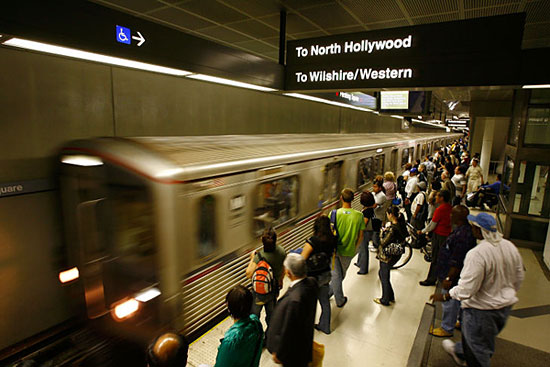
Starting next week, gates on L.A.'s subway system will be locking for good after years of debate and tests.
If you lock it, they will pay.
After extensive testing of latched turnstile gates and rollout of a new TAP card fare payment system, Los Angeles’ long, free trip on a subway without barriers is finally reaching the end of the line.
Next Wednesday, the subway gates at Union Station will be locked as a new era of public transportation rolls out in L.A., following more than two decades on an honor system that critics say unfairly penalizes paying passengers while leaving millions of dollars in revenue on the table.
David Sutton, Metro’s deputy executive officer in charge of the gate-latching project, said the lengthy testing period has been “a real eye-opener,” with consistent results in every test location: fewer boardings but a lot more paying customers using TAP cards.
“The data doesn’t lie,” Sutton said. “When we latch gates, we see less riders, more TAPs, more [vending machine] activity and more revenue.”
In 30 tests at Metro stations conducted earlier this year, sales at ticket vending machines spiked by nearly 30%, with 6,919 additional passengers paying to board trains, compared to the normal volume of paying passengers at each location.
Trains were less crowded because 14% fewer riders got onboard.
And as gate-latching tests intensified and enforcement was heightened, it seemed to create a lingering deterrent to would-be fare beaters. From October through December of 2012, fare evaders made up an estimated 18% of subway riders; from January through April of this year, with testing underway, that number dropped to 13%. So-called “fare checks” by sheriff’s deputies or security officers more than doubled—from 36,588 in October to 74,482 in April. And citations went through the roof, from 881 issued in October to 2,451 in April.
Overall, the testing results suggest that the agency could be able to recover between $6 million and $9 million annually in lost revenue once the subway and existing light rail gates are latched system-wide.
Supervisor and Metro Director Zev Yaroslavsky, a leader in efforts to get the gates latched, has made the case that it’s more than just a matter of money.
“It’s not fair to those people who pay to have a significant percentage of people who don’t pay,” he told the media last month. “The credibility of the enforcement system is undermined. It’s human nature to say, ‘If he’s getting away with it, why should I pay?’ ”
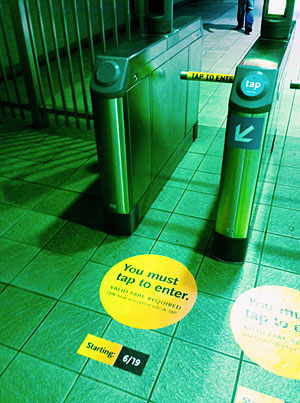
No tap-dancing around it: It will be mandatory to TAP to enter subway gates at Union Station starting Wednesday. Photo/Metro's The Source
It’s been more than 20 years since L.A.’s first subway—the Red Line—opened on an initial stretch of 4.4 miles. And it was five years ago that Metro’s Board of Directors voted to install gates in the subway and some light rail stations, citing security concerns and revenue losses of an estimated $5.5 million a year due to fare evasion.
“Metro remains the only subway operator in the country to operate a barrier-free system,” Yvonne B. Burke, then a Los Angeles County supervisor and Metro board member, said at the time. “That freedom has come at a significant cost to the agency’s bottom line as a result of fare scofflaws.”
Next week’s latching of the first subway gates can be seen as a coming of age moment in the progression of L.A.’s public transit system, which has grown exponentially in recent years and moved from comedian’s punch line to nationally-recognized point of pride.
But getting from there to here has been anything but an express trip when it came to getting the turnstiles locked.
One big stumbling block was the move from paper tickets to the TAP cards needed for passengers to be able to open locked gates. The transition initially prompted widespread confusion and complaints among would-be users, particularly seniors unable to find a way to buy their reduced-priced tickets in the new TAP system. New signs were installed and instructions on vending machine screens were retooled to simplify the process.
Regional transit agencies also needed to be recruited to join the TAP system; by the end of next year, 24 providers will be onboard. Integrating Metrolink passengers’ paper tickets with the TAP system proved to be a special challenge. Eventually, a special chip embedded in Metrolink tickets was developed so that passengers on the commuter rail system can get through locked gates when transferring to a Metro subway or light rail line.
A final test will be run Friday at Union Station, before the Red and Purple lines there are permanently latched on Wednesday, June 19. After that, work will begin on individual subway stations, with locked gates expected to be in place at all Red and Purple line stations by the end of August.
From there, the process moves to the transit system’s light rail stations, which cannot be completely locked because not all of those stations are equipped with gates. Light rail stations with gates on the Gold Line will be latched in October, on the Green Line in December and on the Blue Line in January, 2014.
Metro’s Sutton said the agency has heard some complaints during the lengthy gate-latching testing process but has received far more positive comments, chiefly along the lines of:
“Thank God. Why did you wait so long?”
Posted 6/13/13
Finding foot room at CicLAvia
June 6, 2013
Deborah Murphy’s first experience with CicLAvia was no smooth ride. She was walking her Jack Russell terrier down the sidewalk in East Hollywood when she decided to make a move to the car-free streets.
“Get out of the road with your dog, lady—this is for cyclists, stay off the street,” she remembers someone yelling.
When the next CicLAvia brought more shout-downs, the long-time pedestrian advocate and founder of Los Angeles Walks decided to form WalkLAvia, a group aimed at staking pedestrians’ claim to a share of the roads during the events.
“This is an open streets event and people should be out there walking or on bikes or doing cartwheels or whatever they want to do,” Murphy said.
No one would love to see that more than CicLAvia’s organizers, who’ve been pushing for that kind of inclusivity from the beginning. To make that point abundantly clear, they’re billing the upcoming
June 23 event along Wilshire Boulevard’s “Miracle Mile” as “the most walkable CicLAvia ever!”
“This all feeds into the ultimate purpose of CicLAvia—to connect people with their community in a way that is not possible in a car,” said CicLAvia spokesman Robert Gard. “On bike and, more specifically, on foot, you are really able to interact with your fellow Angelenos.”
But turning that long-held aspiration into a reality has proven increasingly elusive as the event’s popularity has grown. The last event, which opened a 15-mile stretch of streets from downtown to Venice Beach, drew a crowd of about 180,000 people, according to Gard. The overwhelming majority of them were on bikes. “There are so many bicyclists now, walking appears to not be part of it,” Gard said.
Unlike the last route, however, the new one along Wilshire Boulevard will be just 6 miles, with pedestrian-only zones at each end. Although architecture tours and other walker-friendly activities are planned, organizers think the location itself may lure more walkers. The Wilshire route will offer more street life and more sights—from MacArthur Park to Koreatown to “Miracle Mile,” with its museums and vibrant arts scene.
Of course, any event with “cycle” in its name is bound to attract a bike-heavy crowd. But part of the challenge is simple growing pains, Gard said. CicLAvia was inspired by ciclovías in Bogotá, Colombia, which began in the mid-1970s. L.A.’s first event was held just three years ago, and local cyclists jumped at the chance to freely ride streets, where automobile traffic normally makes biking nerve-wracking, even perilous.
Once people realize CicLAvia events are here to stay, bike riders won’t jump at the chance to ride every one of them for fear they’re missing a once-in-a-lifetime opportunity. “In talking with our peers in Central and South America, once they were more established, people understood it better,” Gard said. In time, serious bicyclists came to accept that ciclovías were for riders of all ability levels—and for pedestrians, too.
Alissa Walker, a member of Los Angeles Walks’ steering committee, said attitudes have already started to change.
“It has gotten a lot better,” Walker said. “At first, people didn’t understand that it wasn’t a race or something. It was possibly dangerous.”
CicLAvia organizers, in hoping to encourage that evolution, highlighted the problem using a video of a disabled man describing how he was verbally abused and directed off the streets because he was on a special, motorized device to accommodate his disability.
The City of Los Angeles’ first-ever pedestrian coordinator, Margot Ocañas, has participated in all six CicLAvias—sometimes on foot, sometimes on bike. She believes that continued, heavy interest from cyclists will mean that the roads “below the curb” will probably remain dominated by bikes, while pedestrians will take the sidewalks. For safety’s sake, she said, that’s not necessarily a bad thing.
Creating more pedestrian-only areas could help bring out more walkers, Ocañas said. She also envisions using the main route as a “launch pad for walking activities that tentacle off into other areas.”
No matter how CicLAvia evolves, everyone agrees that it should keep on rolling, stepping and hula-hooping.
“The fact that the bikes and pedestrians are having that conversation,” Ocañas said, “I’ll take it any day over bikers or pedestrians having that conversation with a car.”
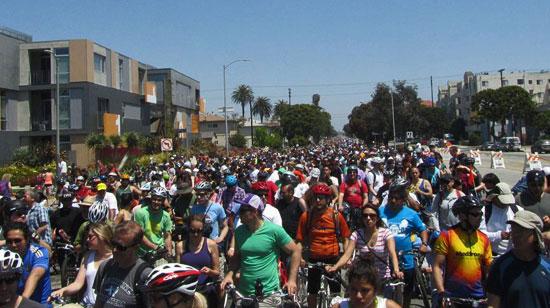
There were so many cyclists at April's event that they became walkers, like on this stretch of Venice Boulevard.
Posted 6/6/13
Orange crush
May 16, 2013
The Orange Line is feeling the squeeze. An immediate success upon its opening in 2005, ridership continues to surge on the San Fernando Valley’s dedicated busway, which runs from Woodland Hills and Chatsworth to North Hollywood. The line currently handles more than 30,000 passengers on an average weekday, making it the second busiest bus line in Los Angeles County. While that success is something to celebrate, elbow room is getting hard to come by.
“Yesterday it was pretty miserable,” said Mark Hill, who commutes between Sherman Oaks and downtown Los Angeles. “You had people letting the bus go because you could just not fit any more.”
Metro plans to relieve some pressure by adding additional service. Next week, the agency’s Board of Directors is expected to take action on an annual budget that includes $1.2 million for more midday buses on the Orange Line. More late night service was also added recently, and increased Saturday service is planned for late June.
Jon Hillmer, a 30-year veteran in Metro’s bus operations, said the popularity is due to the line’s speed and convenience.
“It offers rail-like service on rubber tires,” Hillmer said. “People board at stations, wait on platforms and pay their fares at machines.”
The line also provides important connections to other transit options. At Chatsworth station, it connects to Metrolink’s service to Ventura County. At the North Hollywood station, it connects to the Red Line subway, which provides access to Hollywood, downtown L.A. and the rest of Metro’s rail system.
While improvements are planned to handle the growth in ridership during off-peak hours, rush hour is a different story. One additional bus trip will be squeezed onto the back end of the peak traffic period but, after that, the agency is just about maxed out on how many buses it can run at a time. Among other issues, the line is constrained at intersections with north-south roadways, which are managed by the city of Los Angeles’ Department of Transportation.
“Running buses every 4 minutes during rush hour is the best we can do under the current traffic configuration,” Hillmer said. “The city is reluctant to go below the 4-minute frequency level.”
Jonathan Hui, a spokesman for the city agency, said it allows buses to pass through the intersections every two minutes, but they only get special priority—early or longer green lights—every four minutes. That preferential treatment is important to keep the line moving swiftly.
“Not everybody can get the green at the same time,” Hui said. “The Orange Line is obviously important, but so are drivers, pedestrians and bicyclists.”
The two agencies are currently working on a solution to the problem. Hillmer said possibilities include sending two buses in tandem through intersections, or getting shorter but more frequent green lights to enable more buses to get through.
While the rush hour fixes remain a work in progress, adding extra buses during off-peak hours should be a big help to riders who crowd the Orange Line before and after rush hour.
“At 7:45 p.m., there are still a lot of people waiting, ” said Isabel Barbosa, who commutes from her home in Woodland Hills to downtown L.A. Even at 8:30 p.m., “it’s usually standing room only,” said another commuter, Ian Tudor.
Most of the current rider congestion occurs between the station at Sepulveda Boulevard and North Hollywood, but as last June’s extension of the line to Chatsworth matures, Hillmer expects more growth on the western end.
Ridership probably hasn’t even peaked for the year. The months of September and October, when students return to school, are typically the busiest. The extra riders should push the line’s numbers closer to those of Metro’s busiest bus line—the 720 Rapid, which runs between Commerce and Santa Monica on Wilshire Boulevard and averages about 40,000 riders each weekday.
Despite the ridership boom, Orange Line commuters like Mark Hill say they appreciate the smooth, fast ride the line offers—even when it’s standing room only.
“The buses are nicely appointed,” he said. “There’s plenty of stuff to hang on to.”
Posted 5/16/13
Making tracks to the Westside
April 18, 2013
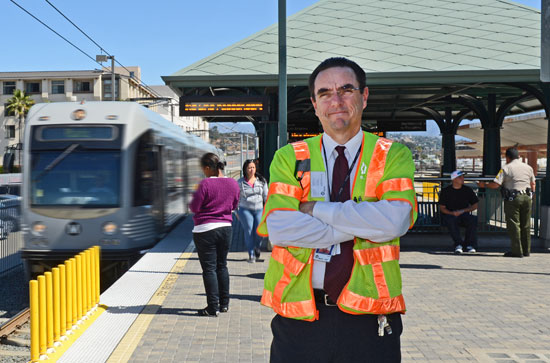
Metro's rail operations chief, Bruce Shelburne, says bike ridership on the trains has gone "sky high."
Bruce Shelburne is hoping for the best. But he’s bracing for “a learning experience.”
As Metro’s executive director for rail operations, Shelburne will have his hands full this Sunday, when the hugely popular CicLAvia winds its way for the first time from downtown Los Angeles to Venice, promising to pack the rail system with riders headed to points along the 15-mile route. At the same time, the Los Angeles Times Festival of Books and the Grand Prix of Long Beach will also be feeding crowds onto the rail lines.
Still, Shelburne, a 26-year Metro veteran, says he’s learned not to get overly stressed by the logistics and pitfalls of his job. “I’m learning to let go a little bit,” he says. “Otherwise you’re going to find yourself on the wrong end of a shovel, six-feet under.”
Shelburne expects one major CicLAvia hotspot to be the new Expo Line’s Culver City station, which, for now, is the closest stop to the sea. That end-of-the-line location will make it a major—and potentially clogged—entrance and exit point for people interested in traveling only along the route’s western end. Culver City’s elevated station might also complicate things because cyclists will have to carry bikes up and down stairs or crowd into elevators.
Increasing the potential congestion, CicLAvia has placed one of its “hubs” there to provide water, restrooms, and bike repairs, while Culver City and its businesses are planning a variety of entertainment options, including free massages and live music to complement food and shopping deals. A bike valet will help people make sure their wheels are secure while they browse the area.
Throughout Metro’s rapidly expanding rail system, Shelburne and his staff will also have to grapple with the reality that many CicLAvia passengers will be riding the rails for the first time and are unfamiliar with the agency’s TAP Card system, which can be confusing to the uninitiated.
“Trust me,” Shelburne says, “if that becomes a bottleneck, we’ll undo that real quick. We’ll address it with any means necessary to get people moving.”
Shelburne says that he sees CicLAvia and other major seam-stretching L.A. events as laboratories for lessons that can be applied in the future. For example, based on past CicLAvias, Shelburne says he’s doubling the number of trains on some lines. And while bikes are normally limited to two per train, Shelburne says, “we tend to look the other way on this kind of day.” In fact, Metro staffers will try to devote one car or maybe more per train to cyclists.
“It’s not all about the bikes,” Shelburne says. “We can’t take all the seats out. We have 100 million riders boarding the system annually and the majority of them don’t use bikes….The advantage is that bicyclists, especially the experienced ones, tend to work well with each other.”
(On Thursday, the regional rail service Metrolink announced it would be putting all 17 of its specially-outfitted “bike cars” into service on Sunday to serve the CicLAvia crowds. More information is here.)
While Shelburne is modest about his team’s successes managing past events, he’s particularly proud of one of his personal contributions—deploying Metro staffers to help people navigate the system and provide a human face to agency. Humor helps, too, he says. “If you’re not afraid to make a joke at your own expense, it goes a long way.”
On the future of bikes and trains in general, Shelburne sees a growing challenge and the need for a new relationship between cyclists and other passengers. “It seems like our bicycle ridership has really gone sky high,” he says.
Metro has already removed seats from older rail cars, and new cars will include additional accommodations for bicycles. But in the long term, Shelburne says, Metro will need to look at additional measures, such as arranging seats around the edges of cars to open more floor space.
While Shelburne admits he’s not one to jump on a bike very often, he does spend a plenty of time on the rails each day. He commutes from his home Oxnard to Union Station in downtown L.A.—a 70-mile trip that takes more than 90 minutes each way. On the way home, it’s a chance to catch up with work. But in the morning, he says, the smooth ride is the perfect opportunity for a pre-office nap.
“What rail buys,” he says, “is peace of mind and consistency. It just calms you down and you don’t have to worry about some of the idiots on the road.”
Trying to beat Dodger traffic blues
April 4, 2013
Every spring, it happens like clockwork: Vin Scully’s voice lilts across the metropolis, Dodger dogs become an essential food group and downtown L.A. resigns itself to 80-plus nights of traffic headaches.
This year, though, there’s an upstart rookie in town: a 1.5-mile dedicated Dodger Stadium Express bus lane running along Sunset Boulevard, aiming to revolutionize how the getting-to-the-stadium game is played.
With the Dodgers under new management and the stadium freshly spiffed up with a $100 million renovation, aggressive efforts are underway to crack one of L.A.’s thorniest traffic dilemmas—getting fans into and out of Chavez Ravine when most home games overlap with downtown’s always lively afternoon rush hour.
“There’s no room for error,” said Aram Sahakian of the city Department of Transportation’s special traffic operations division. For the home opener Monday, “we threw everything we had at it.”
It paid off on the first day, he said: “I don’t think ever in Dodgers history we’ve cleared [stadium traffic from] Sunset on Opening Day before the first pitch…It was a huge success.”
But while ridership on the Dodger Stadium Express buses is up—9,750 so far this year, compared to 7,157 at the same time last year—general traffic downtown this week has been, well, foul.
“Obviously, when you take a lane away, it will have an impact,” Sahakian said, “but it’s also driver behavior. There’s some tweaking to be done.”
The new lane on Sunset, while a boon to game-goers who ride the express buses, is clearly confounding some drivers.
“It’s new to motorists; they don’t know what it is,” Sahakian said of the dedicated lane, which begins at Figueroa and runs through Elysian Park to the stadium.
Those used to driving in the curbside space now taken up by the new, 12-foot-wide bus lane will need to adjust by changing their lane choice, or their route, he said. And those headed to the game by car should give some serious thought to taking the bus next time. (The buses depart from Union Station at 10-minute intervals before each game, and every 30 minutes while the game is in progress.)
Other adjustments also are in the works. Sahakian is proposing that the city’s Automated Traffic Surveillance and Control system be up and running for all home games, as it was on Opening Day, so real-time adjustments can be made to traffic signals. Sahakian also is suggesting that cars carrying four or more people be allowed to use the special lane.
“We’re brainstorming,” he said. “It’s a challenge. The venue, the location, is a challenge for us.”
This year, enthusiasm about the team and its new owners means likely higher attendance, with 20 games already sold out, Sahakian said. And that means heavier traffic.
“We know attendance is going to be very high. We’re excited about it, but with that comes challenges.”
Renata Simril, the Dodgers’ senior vice president for external affairs, said the organization is heavily promoting Dodger Express bus ridership and the new dedicated lane, including on Scully’s popular broadcasts.
She said the Dodgers have also made adjustments to make it quicker for motorists to get into the stadium parking lots. “Ambassadors” now walk down lines of waiting cars to accept parking payment. (They’re still accepting cash only, but by next season should be equipped with mobile devices that will allow them to take credit cards.)
In addition, the ballpark is opening half an hour earlier before games—at 4:30 p.m. for a 7:10 p.m. start.
“Every little bit helps,” Simril said. “We’re trying to take a multi-pronged approach.”
The Dodger Express buses, which are free to riders with a game ticket and $1.50 each way for other passengers, run on clean-burning compressed natural gas and are funded by a two-year, $1.1 million grant from a regional air pollution reduction committee.
City officials and the Dodgers are hoping that increasing express bus ridership will reduce the number of cars coming into the stadium, and the dedicated lane on Sunset is seen as an important tool in persuading people to hop aboard.
“Taking one lane away is going to impact people driving to the stadium,” Sahakian acknowledged, “but at the same time, you’re incentivizing mass transit.”
Looking at the long-term picture, though, Sahakian thinks a bolder solution may be called for.
“My personal recommendation,” he said, “would be a monorail.”
Posted 4/4/13
Coldwater Canyon’s pipe with a past
March 14, 2013
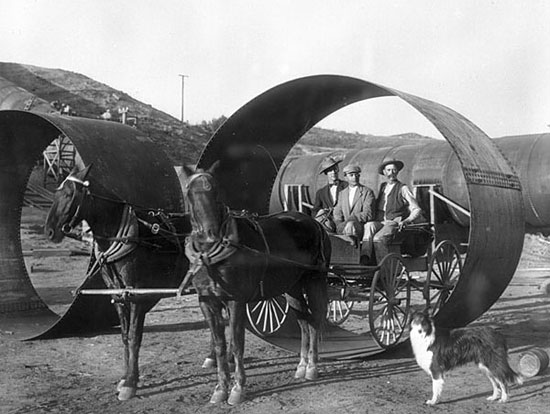
Undated DWP photo shows pipe used for aqueduct. Smaller pipe of the same riveted steel built the trunk line.
It was 1913 when William Mulholland famously declared, “There it is. Take it.”
But it wasn’t until 1915 that thirsty folks down in the city of Los Angeles could actually take a swig of all that Owens River water pouring into the Los Angeles Aqueduct.
The missing link? The City Trunk Line, known at the time as the “San Fernando Syphon,” an underground water pipe stretching from Sylmar across the Valley (not yet part Los Angeles) through a tunnel in the Santa Monica Mountains to the Franklin Reservoir above Beverly Hills.
With the trunk line’s completion on June 6, 1914, and connecting pipes finished the following year, Mulholland’s aqueduct at last had a direct connection to the city whose growth it would fuel so explosively in the decades to come.
Now, 99 years later, a new generation of Angelenos is feeling its power. And not in a good way.
Commuters on Coldwater Canyon Avenue, a major thoroughfare between the San Fernando Valley and the Westside, recently learned that the street will be closing between Mulholland Drive and Ventura Boulevard for nearly five weeks, from March 23-April 25, so that the city’s Department of Water and Power can replace a 1.3-mile segment of the aging pipe. [Updated 4/24/13: Coldwater Canyon has been reopened, two days ahead of schedule, city officials announced. However, restrictions on left-hand turns are still in place through June 1.)
Clearly, the inconvenience will be sizeable. As Supervisor Zev Yaroslavsky told reporters at a news conference this week announcing the closure: “You can put lipstick on a pig, but it’s still a pig. And this is a pig of a project.”
But he and other local leaders emphasized that the work is important—and unavoidable.
Corroded and susceptible to leaks, a section of the trunk line burst sensationally in 2009, sending millions of gallons of water bursting through the pavement and damaging homes and businesses around Coldwater Canyon and Ventura Boulevard. Earlier, in 2002, the line ruptured in Pacoima after workers inadvertently scraped the pipe, hastening corrosion on that segment to the breaking point.
The Coldwater Canyon closure comes after some 35-45% of the old pipe already has been replaced; modernizing the entire trunk line is expected to take about ten years, said Susan Rowghani, director of the DWP’s water engineering and technical services division.
About 25,000 gallons of water gush through the trunk line on the average each minute. With a diameter ranging from 62 inches to 72 inches in various places, the pipe is smaller than the massive pipes of the aqueduct itself, which range from 84 inches to 120 inches and were photographed at the time of construction with automobiles and even horse-drawn buggies parked comfortably inside. Other than size, though, the pipes used in the aqueduct and trunk line were virtually identical, made of the same riveted steel that was the construction standard at the time, said Fred Barker, manager of water transmission operations at the DWP and the agency’s unofficial historian.
Despite the trunk line’s ripe old age, he said, it’s far from unique in the city’s subterranean water world, where 287 miles of the DWP’s 7,289 miles of pipe date back to 1914 or before.
There’s even a cast iron pipe from the mid-1880s that still runs under 7th Street downtown for six to eight blocks, he said. There are no plans to replace it at the moment. “It’s performing very well,” Barker said. “There’s no need to replace a pipe that doesn’t leak.”
Sadly, the same can’t be said of the venerable City Trunk Line. So it’s with a sense of respect for history that Barker marks its inevitable passing from the scene.
“We talk about this event in 1913, when Mulholland and 40,000 people were out there and the water came down the hill and he said, ‘There it is. Take it.’ But the only way they could take it was in little souvenir bottles…if you wanted that water, you had to go out to Sylmar to get it.
“They had to get it to the city. This is the pipe that did it.”
Now the riveted steel pipe of a century ago is giving way to modern day welded steel—which, Barker said, “is going to last at least as long—and maybe twice as long.”
Posted 3/7/13




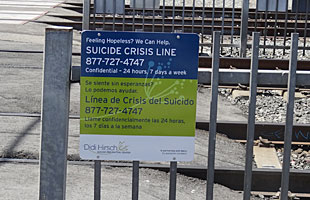
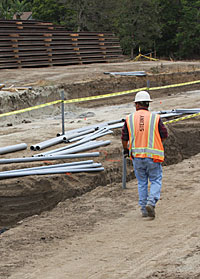
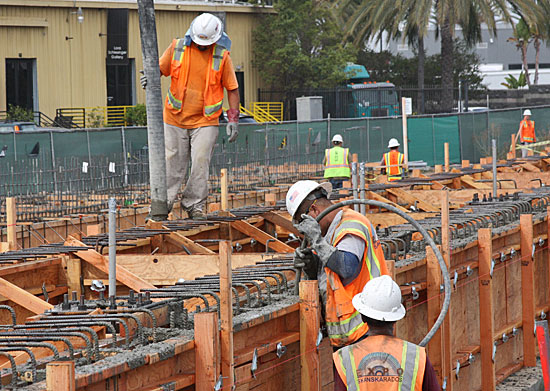
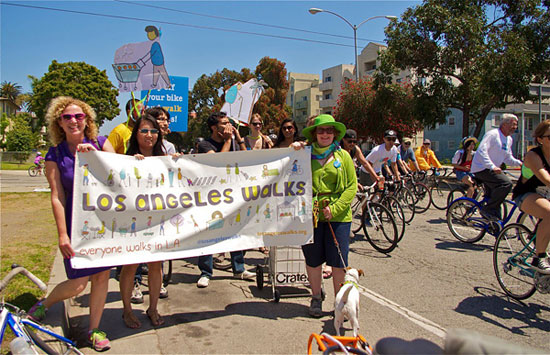
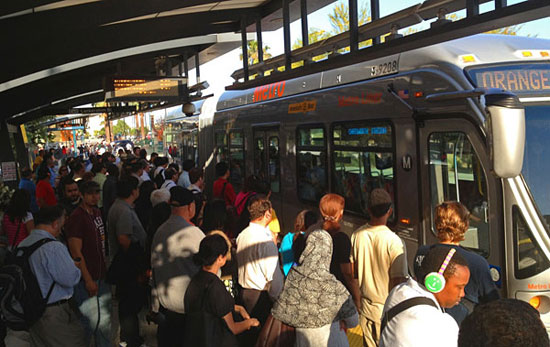

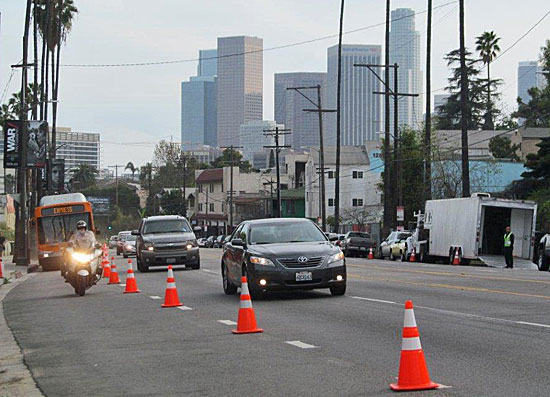
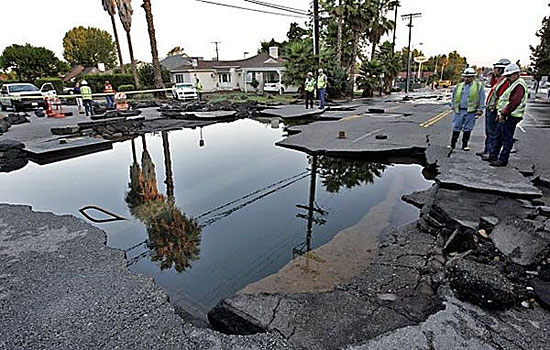







 405 bridge work causes a stink
405 bridge work causes a stink

